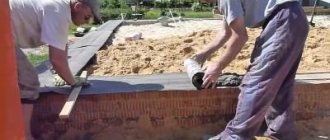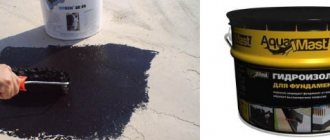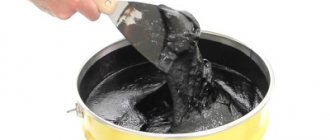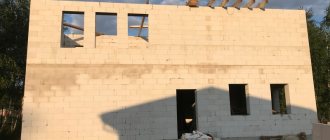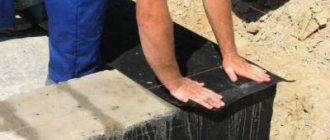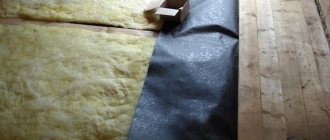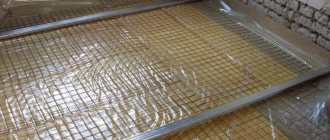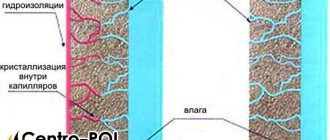To protect concrete structures from the harmful effects of moisture, a set of waterproofing measures is carried out using various moisture-resistant materials.
Bitumen mastic allows you to protect structures from excessive moisture.
One of the effective ways to protect a structure from moisture is the use of bitumen mastic. This material is often used for waterproofing foundations and roofs. Before carrying out such work, it is necessary to correctly calculate the bitumen consumption, which will be discussed further.
Types of bitumen mastic
There are several dozen trade names of bitumen mastic, but, in fact, there are only a few types of mastic, or more precisely, three. They differ in the method of application, as well as in composition.
The first version of mastic is used together with aggressive chemical solvents. They are most often based on synthetic materials, which, when mixed, produce a solution that can be applied to the surface to be treated without preheating it. A distinctive feature of such mastics is their high danger, therefore it is necessary to work with them only when using means that protect the respiratory system.
The second option, unlike the first, although it consists of synthetic materials, however, ordinary water acts as a solvent for it.
This greatly increases the safety of its use. The only difficulty in using them is the need to comply with environmental temperature parameters. They should not go beyond the range from +5 to +30 degrees.
The third option of mastic has been used for quite a long time.
It is traditional, but at the same time such mastic creates a lot of difficulties. To apply it, it needs to be heated and special tools are used for this. Hot applied mastics are dangerous for craftsmen when working with them, since their melting point is quite high, which increases the risk of thermal burns.
Features of use
To obtain a high-quality insulating layer, bitumen-rubber mastic must have a uniform composition by volume, so it is thoroughly mixed before use. To obtain a composition with a certain consistency, the use of one or another solvent is sometimes required.
When carrying out work in conditions of low ambient temperature, before use, the container with mastic should be placed for some time in a warm room.
The material is applied to a carefully prepared base, which should be free of dirt and moisture. Before creating the protective layer, the remnants of the previously applied coating, dust, and ice are removed.
When treating a porous surface, a preliminary application of a layer of primer is required. Metal structures are thoroughly cleaned of rust using mechanical devices and coated with special agents that prevent the development of corrosion processes.
Consumption of bitumen mastic per 1 m2 when waterproofing the foundation
When waterproofing the foundation, all of the listed main types of bitumen mastics can be used.
However, their consumption rates are somewhat different. Cold application mastics are consumed in a volume of 1-1.5 kg per 1 m2, provided that the thickness of one layer is about 0.5-1 mm. Consumption increases proportionally with increasing number of layers.
Hot mastics, due to technological difficulties, are applied in a thicker layer - 2 mm. Therefore, the consumption of raw materials, accordingly, increases and amounts to 2 kg per 1 m2. It is worth considering that the number of layers when waterproofing a foundation can be less than two, that is, the consumption must be at least doubled.
Work order
Let's look at how to properly apply bitumen mastic with your own hands to waterproof a foundation. The algorithm of actions is as follows:
- the foundation surface is cleared of debris and, if necessary, repaired;
- material is being prepared. Here it is important to first clarify (if necessary) how to dilute the bitumen mastic, think about how to apply hot bitumen (if this type of material is chosen);
- dilute the optimal amount of mastic for the job;
- apply material to the surface;
- Ensure the layer is completely dry.
To clean the surface, use a stiff brush, after which everything is wiped with a wet cloth and allowed time to dry. If you apply the material cold, you should specify how to dilute the composition for ease of use.
The consistency of the solution should resemble jelly in thickness.
The mastic prepared for use is applied to the concrete base with rollers and brushes. Don't know how to apply? Stretch the mastic material in strips in a certain direction (for the vertical section). When isolating a horizontally located area, you can pour a little mastic onto it with a ladle and stretch it over the entire surface with a brush.
How long does it take for cold bitumen mastic to dry on a foundation? Here the task is simplified, since the final hardening of the applied layer occurs within a day.
If it is necessary to apply a second layer, you must wait at least twenty-four hours.
Consumption of bitumen rubber mastic AquaMast
Another type of mastic produced by Technonikol is the bitumen-rubber mixture AquaMast. It is used not for external, but for internal waterproofing of premises, for example, for treating bathrooms. Its consumption varies from 0.5 to 1.5 kg per 1 m2
- Date: 08/13/2015 Rating: 23
Work on external waterproofing of building foundations is an important element at the construction stage.
Sufficient attention should be given to this issue. This is due to the fact that monolithic concrete, although it has increased strength, is of a finely porous structure in its structure. If your house is also located in an area where the groundwater level is high, ignoring or inattentive attention to waterproofing work can cause you a lot of trouble in the future.
Foundation waterproofing scheme using bitumen mastic: 1. Soil. 2.
Backfill soil.3. Profiled membrane. 4. Bitumen mastic. 5.
Transitional side (fillet).6. Reinforced concrete foundation structure. 7. Swelling profile.
8. Crushed stone.9. Bitumen primer. 10.Sand.
11. Mineral wool for pipes. This may result in the appearance of dampness, mold or water in the basement. All this signals that the waterproofing does not fulfill its function of protecting against moisture.
And, most likely, the reinforcement that is part of the concrete foundation is susceptible to corrosion. Corrosion is a destructive process that can ultimately cause a decrease in the load-bearing capacity of the foundation and a shortening of the life of the house. Carrying out waterproofing work with bitumen is one of the ancient ways to protect not only concrete and brick products, but also metal, wood and other building materials. The bitumen consumption for the work will be determined based on various factors, which we will discuss below.
Varieties
Bitumen is divided into two types: artificial and natural. The first type is obtained during oil processing; heavy resinous compounds called tar precipitate. It is from this material that the artificial version is made.
There are four types of production of bitumen-based products, such as:
- residual compounds are solids that have low viscosity. They are generated by vacuum stripping;
- oxidized bitumens are obtained after processing tar using oxygen treatment. This bitumen has greater plasticity and heat resistance;
- cracked bitumen is obtained as a result of the production of gasoline, after the distillation of crude oil, such bitumen has increased fragility;
- Compound bitumens are formed when various oil residues are mixed together.
Natural bitumens are boiled in boiling water and are widely used in the creation of paints and varnishes. They are presented in three types:
- bitumen from layers, because many rocks (limestone, sandstone) have a high bitumen content;
- surface variants can be found on the surface of rocks;
- vein types have a low percentage of mineral additives.
According to the method of application, bitumens are differentiated into the following:
- for construction - bitumen from oil, which has the designation BN, is used for concrete;
- for roofing - petroleum, roofing bitumen is designated BNK, suitable for metal;
- for road surfaces - oil for roads is designated BND.
When choosing anti-noise bitumen and BPM mastics, you should pay attention to the following criteria:
- how many years can it serve;
- consumption per square meter;
- what is the price;
- ease of installation;
- temperature conditions and setting time;
- where work can be carried out - inside or outside the facility.
Bitumen is a petroleum product from which construction and roofing waterproofing is made.
Construction bitumen must comply with GOST 6617-76 of 2002. In accordance with GOST, construction bitumen is used for waterproofing the underground part of a house or foundations, for repairing roofing and filling leaks in buildings. Modern waterproofing coating or lining materials based on construction bitumen have polymer additives. For example, Technonikol bitumen mastic, which received many positive reviews from users. Standards for bitumen
According to GOST, roofing and construction bitumen is produced in several types:
Roofing:
- As an initial coating of bitumen and for impregnation of BNK 45-190
- For impregnation of BNK 40-180
- For covering roll-type waterproofing BNK 90-30.
Construction bitumen:
- BN 50-50
- BBN 70-30
- BN 90-30
In accordance with GOST, construction and roofing bitumen has the following technical characteristics:
- Combustion temperature - 220-300 0С,
- Self-ignition 386 0C (Flammable substance according to GOST 12.1.044).
- Hazard class 4 according to GOST 12.1. 007. (Non-toxic, does not emit toxic fumes, but if it gets on the skin or mucous membranes it can cause a thermal burn).
In order to protect yourself when coating with bitumen, you need to wear special protective clothing, and during internal work, provide exhaust hood and good ventilation.
For coating waterproofing, materials based on construction bitumen are used:
- Liquid bitumen BN3, BP5, DN-1V;
- Solid BN-3,4,5.
- Bitumen polymer mastic.
- Bitumen-rubber waterproofing.
How to calculate correctly
When making calculations, it is necessary to take into account the thickness of the layers, how many layers will be made, and the dry residue indicator. It was written above what standards of thickness and number of layers are applicable for different types of work. It is also necessary to know the processing area.
To make calculations easier, there is an online calculator that can be easily found on the Internet. They are often available on the manufacturers' website. The received data is entered into the appropriate boxes and the answer is received in kilograms. This is convenient, because on the website you can immediately see the consumption rates for a certain mastic.
When making calculations, it is necessary to take into account the thickness of the layers, how many layers will be made, and the dry residue indicator.
Functionality of bitumen coating
The main strength of any concrete frame is provided by iron reinforcement. But, despite the durability and solidity of the concrete base, there are many microcracks through which moisture can easily get inside. And when the reinforcement comes into contact with moisture, it will become corroded and lose a number of its qualities. The foundation is always subject to several loads at once: external, from a wooden house and groundwater pressure. Violating the integrity and strength, there is a risk of deformation of the entire house. And under the weight it will simply sink into the ground and burst.
These consequences can be prevented by completely isolating the foundation from moisture. This problem can be solved using bitumen waterproofing. It is called coating based on the method of applying it to the surface. What kind of composition this is and by what standards it is produced, we will talk below.

